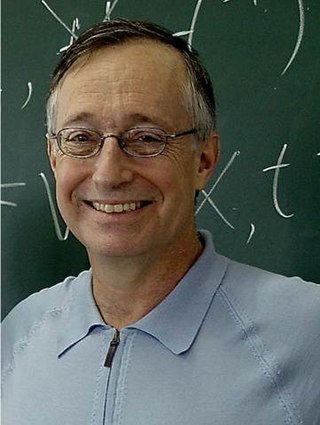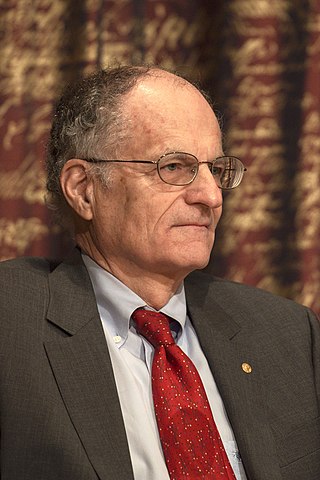
Kenneth Joseph Arrow was an American economist, mathematician, writer, and political theorist. Along with John Hicks, he won the Nobel Memorial Prize in Economic Sciences in 1972.

Economic growth can be defined as the increase or improvement in the inflation-adjusted market value of the goods and services produced by an economy in a financial year. Statisticians conventionally measure such growth as the percent rate of increase in the real and nominal gross domestic product (GDP).
Arrow's impossibility theorem is a celebrated result and key impossibility theorem in social choice theory. It shows that no ordinal voting rule can produce a logically coherent ranking in elections with more than two candidates. Specifically, no such procedure can satisfy a key criterion of decision theory, called independence of irrelevant alternatives: that the choice between and should not depend on the quality of a third, unrelated outcome .

One of the major subfields of urban economics, economies of agglomeration, explains, in broad terms, how urban agglomeration occurs in locations where cost savings can naturally arise. This term is most often discussed in terms of economic firm productivity. However, agglomeration effects also explain some social phenomena, such as large proportions of the population being clustered in cities and major urban centers. Similar to economies of scale, the costs and benefits of agglomerating increase the larger the agglomerated urban cluster becomes. Several prominent examples of where agglomeration has brought together firms of a specific industry are: Silicon Valley and Los Angeles being hubs of technology and entertainment, respectively, in California, United States; and London, United Kingdom, being a hub of finance.

Law and economics, or economic analysis of law, is the application of microeconomic theory to the analysis of law. The field emerged in the United States during the early 1960s, primarily from the work of scholars from the Chicago school of economics such as Aaron Director, George Stigler, and Ronald Coase. The field uses economics concepts to explain the effects of laws, to assess which legal rules are economically efficient, and to predict which legal rules will be promulgated. There are two major branches of law and economics; one based on the application of the methods and theories of neoclassical economics to the positive and normative analysis of the law, and a second branch which focuses on an institutional analysis of law and legal institutions, with a broader focus on economic, political, and social outcomes, and overlapping with analyses of the institutions of politics and governance.
In industry, models of the learning or experience curve effect express the relationship between experience producing a good and the efficiency of that production, specifically, efficiency gains that follow investment in the effort. The effect has large implications for costs and market share, which can increase competitive advantage over time.

A learning curve is a graphical representation of the relationship between how proficient people are at a task and the amount of experience they have. Proficiency usually increases with increased experience, that is to say, the more someone, groups, companies or industries perform a task, the better their performance at the task.

Endogenous growth theory holds that economic growth is primarily the result of endogenous and not external forces. Endogenous growth theory holds that investment in human capital, innovation, and knowledge are significant contributors to economic growth. The theory also focuses on positive externalities and spillover effects of a knowledge-based economy which will lead to economic development. The endogenous growth theory primarily holds that the long run growth rate of an economy depends on policy measures. For example, subsidies for research and development or education increase the growth rate in some endogenous growth models by increasing the incentive for innovation.

Paul Robert Milgrom is an American economist. He is the Shirley and Leonard Ely Professor of Humanities and Sciences at the Stanford University School of Humanities and Sciences, a position he has held since 1987. He is a professor in the Stanford School of Engineering as well and a Senior Fellow at the Stanford Institute for Economic Research. Milgrom is an expert in game theory, specifically auction theory and pricing strategies. He is the winner of the 2020 Nobel Memorial Prize in Economic Sciences, together with Robert B. Wilson, "for improvements to auction theory and inventions of new auction formats".
Robert Joseph Barro is an American macroeconomist and the Paul M. Warburg Professor of Economics at Harvard University. Barro is considered one of the founders of new classical macroeconomics, along with Robert Lucas Jr. and Thomas J. Sargent. He is currently a senior fellow at Stanford University's Hoover Institution and co-editor of the influential Quarterly Journal of Economics.

Thomas John Sargent is an American economist and the W.R. Berkley Professor of Economics and Business at New York University. He specializes in the fields of macroeconomics, monetary economics, and time series econometrics. As of 2020, he ranks as the 29th most cited economist in the world. He was awarded the Nobel Memorial Prize in Economics in 2011 together with Christopher A. Sims for their "empirical research on cause and effect in the macroeconomy".
Robert JamesGordon is an American economist. He is the Stanley G. Harris Professor of the Social Sciences at Northwestern University. Gordon is one of the world’s leading experts on inflation, unemployment, and long-term economic growth. His recent work asking whether economic growth in the US is “almost over” has been widely cited, and in 2016, he was named one of the 50 most influential people in the world by Bloomberg.
The productivity paradox, also referred to as the Solow paradox, could refer either to the slowdown in productivity growth in the United States in the 1970s and 1980s despite rapid development in the field of information technology (IT) over the same period, or to the slowdown in productivity growth in the United States and developed countries from the 2000s to 2020s; sometimes the newer slowdown is referred to as the productivity slowdown, the productivity puzzle, or the productivity paradox 2.0. The 1970s to 1980s productivity paradox inspired many research efforts at explaining the slowdown, only for the paradox to disappear with renewed productivity growth in the developed countries in the 1990s. However, issues raised by those research efforts remain important in the study of productivity growth in general, and became important again when productivity growth slowed around the world again from the 2000s to the present day.
In economics, an agent is an actor in a model of some aspect of the economy. Typically, every agent makes decisions by solving a well- or ill-defined optimization or choice problem.
The economics of religion concerns both the application of the techniques of economics to the study of religion and the relationship between economic and religious behaviours. Contemporary writers on the subject trace it back to Adam Smith (1776).
Real business-cycle theory is a class of new classical macroeconomics models in which business-cycle fluctuations are accounted for by real shocks. Unlike other leading theories of the business cycle, RBC theory sees business cycle fluctuations as the efficient response to exogenous changes in the real economic environment. That is, the level of national output necessarily maximizes expected utility, and governments should therefore concentrate on long-run structural policy changes and not intervene through discretionary fiscal or monetary policy designed to actively smooth out economic short-term fluctuations.
Learning by doing is a theory that places heavy emphasis on student engagement and is a hands-on, task-oriented, process to education. The theory refers to the process in which students actively participate in more practical and imaginative ways of learning. This process distinguishes itself from other learning approaches as it provides many pedagogical advantages to more traditional learning styles, such those which privilege inert knowledge. Learning-by-doing is related to other types of learning such as adventure learning, action learning, cooperative learning, experiential learning, peer learning, service-learning, and situated learning.
Robert Stephen Pindyck is an American economist, Bank of Tokyo-Mitsubishi Professor of Economics and Finance at Sloan School of Management at Massachusetts Institute of Technology. He is also a research associate with the National Bureau of Economic Research and a Fellow of the Econometric Society. He has also been a Visiting Professor at Tel-Aviv University, Harvard University, and Columbia University.
Jess Benhabib is a professor at New York University, and known for his contributions to growth theory and sunspot equilibria.
The Uzawa–Lucas model is an economic model that explains long-term economic growth as consequence of human capital accumulation. Developed by Robert Lucas, Jr., building upon initial contributions by Hirofumi Uzawa, it extends the AK model by a two-sector setup, in which physical and human capital are produced by different technologies. The Uzawa–Lucas model is part of endogenous growth theory.







